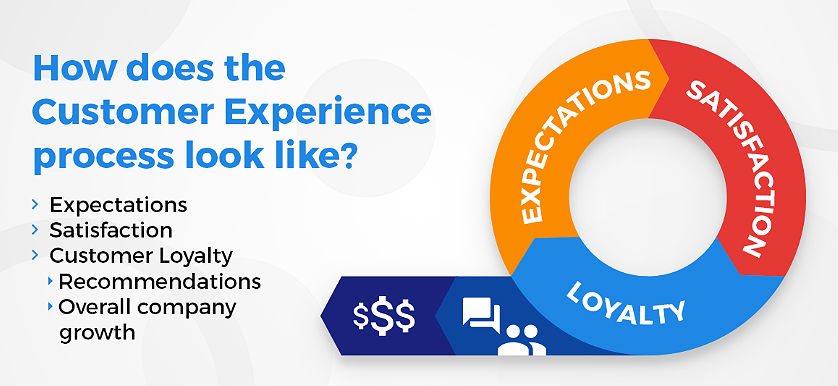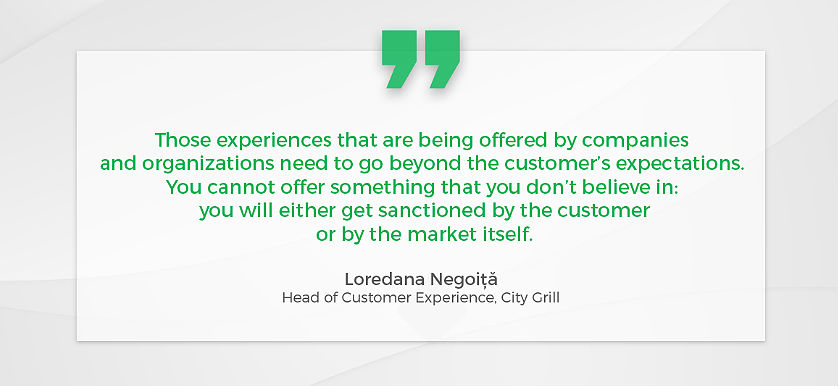Customer Experience – building relationships and generating loyalty

It is no secret that in 2017 one of the most important topics of discussion in the business sector is related to customers. The main questions that need to be answered are: How do you attract customers?; How do you approach leads? – this question led to the development of a new business, called growth hacking; How do you earn their trust? and most importantly: How do you keep them happy, satisfied and loyal?
Customer experience has been around for quite a while now and it is employed by companies around the world. In 2012, a company called Watermark Consulting researched how to best calculate the ROI of publicly traded companies that had a customer experience department and/or strategy, versus companies that did not include such an approach in their business.
Even back then, the results of this report were clearly in the customer’s favor: in a period of five years (2007-2011), companies that implemented a customer oriented policy produced a cumulative total return of over 22%. In comparison, those organizations that lacked a customer experience approach experienced a negative rate of return, more specifically -46%.
The idea here is that not only do customers reward companies that take an authentic interest in them and their needs, but the market itself has already embraced that approach. This has been happening for quite a while now.
CE – the new old idea
So how come we are still considering the customer experience department a new idea? Even though the results of such a department have been proven in the past, companies are still focused on more immediate profit over aspects that they consider secondary, such as focusing on the customer and her/his experience.
This is definitely an ongoing trend in many Romanian companies, but with the constant growth of businesses and the digitization scene developing at such great speed, companies can no longer afford to sit on the sidelines regarding their customer strategy.
Furthermore, it is a phenomenon that Loredana Negoiță, Head of Customer Experience at City Grill Romania, has noticed as well. She was a speaker at this year’s edition of the Customer Relations Management Conference in Romania 2017, a conference focusing on the performance of the customer relations’ area, and has an intense 13 years of experience in the hospitality field.
Ms. Negoiță chose to talk about the current reality of customers in the HoReCa and hospitality business, what they really want and how companies can help them get what they want. Her presentation – Leading Customer Experience – focused on the best case practices brought from the restaurant chains that City Grill manages.
She also mentioned the most important trends of the customer relations’ department all over the world, as well as in Romania. During her session, a quote by Ron Kaufman made an impression and perfectly expressed the status quo of investing in a company’s customer experience approach:
“If you want to stay in business, satisfy customers. If you want to excel in business, delight them.”

What is customer experience exactly?
The customer experience process is defined by Adam Richardson, Group Product Manager at Financial Engines, as “the sum-totality of how customers engage with your company and brand, not just in a snapshot in time, but throughout the entire arc of being a customer”.
Ms. Negoiță sums it up as meeting a customer’s expectations, satisfying that customer and convincing him to become loyal to your company. A customer experience process is comprised of customers’ needs, expectations, the satisfaction we bring to them, the way we impress them during the experience, convincing them to be loyal to the business.
The implementation of customer experience processes represents a definite competitive differentiator, which can help companies define themselves better in a crowded market. The top 3 benefits of implementing these processes, according to Ms. Negoiță, are:
- Gaining a holistic view on your clients’ experiences by analyzing the available data (only what is relevant);
- Creating authentic interactions with your clients on an emotional level, that in turn help you gain a sense of control over the direction of your business and help your employees take better and more thoughtful decisions;
- The clear know-how on how experiences should look like for your clients, conforming with the values of your brand and of your company’s strategy.
Colin Shaw, Founder and CEO of Beyond Philosophy and best-selling author said:
“Customers are not loyal because of the Customer Experience you provide. They are loyal because of the Customer Experience they remember you provided. Furthermore, customers don’t remember the entire experience but only bits and pieces. It is important to get these memorable bits right, or your customer loyalty will certainly go to pieces.”

Understanding your customer
Many business people try very hard to understand their customer base. The most popular question among these professionals is – What do my customers actually want?. These people spend a lot of money to find an answer to that question, either through putting out lengthy surveys that no one is interested in filling, or by organizing costly focus groups to get a sense of what buyers might find attractive.
These old-fashioned methods only complicate the process of finding a relevant answer to that popular question. Maybe the answer is simpler than that. Just think about the best example out there: yourself. What do you crave for when interacting with a service or a brand? The answer can be found inside of us: we want to be treated with respect, we want to trust those that we give money to in exchange for something.
People want to experience the following values: professionalism, credibility and trust, open communication, security, innovation, recognition of their loyalty, relevance, people that really care about them and other similar values. Through processes, employees, the brand and your product/service, people want to obtain the values mentioned above. Obtaining them increases a customer’s satisfaction level. The miracle happens when the expected service meets the actual provided service.
There are certain tips and tricks that one should be aware of to thrive in such a complex and intense field. According to Ms. Negoiță, there are 5 specific points for a business to focus on:
- You need to identify all the points of interaction between customers and your business. Create a customer experience map, get help from your employees, especially from those that are placed in customer touch positions, to get a better insight into the status quo of the interactions;
- Prioritize your decisions based on a special formula: number of customers affected by the decision x, necessary resources x, the company’s/brand’s strategy;
- Gather all available information about your customers from all departments and channels and merge those results. Create a profile of those customers and see what are the most common situations and scenarios they go through;
- Combine different approaches based on feedback received from your customers, but make sure that the teams that are executing these approaches are 100% motivated to fulfill them. You do not want a bored customer support agent to try to solve your customer’s problems;
- Test, measure, fail, learn from your mistakes, celebrate your wins and move on with a clearer vision. If you want to stand out, you will need to experiment, even though experimentation is scary because there’s a risk factor involved.
Generating and developing loyalty
You may be asking yourself “well, we are trying to provide the very best customer experience, but to what avail?”. In short, the end result of any effective customer experience is to get the customer to the final and most important stage of the process: the loyalty phase. The dream of any business owner is for people to recognize the value of the company, to see the brand as a love brand and subsequently act as brand ambassadors.
Loyalty is a very hot topic, because it is not easy to get to that stage with your customer. You have to have patience and to work hard until you get there, just like in any other relationship. They need to get to know you and if they like what they experience, they will come back.
If the quality of their experience does not decrease and stays the same during multiple occasions, they start trusting the level of professionalism of your business. That is when they feel appreciated and valued by your organization, that’s when the magic happens.
Each business and sector can develop very specific loyalty programs, catered to their target audience and business identity. There are numerous examples in the field of customer experience in this sense, such as:
- Lex Brodie’s Tire, Brake and Service Store from Hawaii that created a donations community, in which a customer can pick an NGO for which they want to donate a percentage of their bill. In 18 months, the company has raised 26 000 dollars for charity, thus involving their customers into something more valuable than a simple purchase process.
- Audi Unite tried a sharing-economy tactic with its customer base. In 2015, it allowed customers from Sweden to share a car via their special app. The company emphasized the role and importance of community in everyday life, thus building stronger relations in the Audi community.
- Umbrella Here launched in 2014 a Bluetooth device together with a specialized app, through which people could signal to others via a LED-based device that they have an umbrella, ready to be shared with others during rainy times. Again, this specific tactic builds relationships within a community, solves problems for others and spreads the word about the brand.
These programs can be used strategically throughout the customer experience process. On the one hand, they can be used to increase loyalty and to offer a sense of unity to all customers. On the other hand, they provide great customer acquisition opportunities, diving into other customer segments.
For example, City Grill took advantage of this opportunity by merging it with the needs of a highly digitized reality. Thus, they created the Out4Food app, a gamified mobile application through which customers can have more autonomy in their experience with City Grill restaurants.
With this app customers can directly make reservations at their preferred restaurant, order their food of choice and pay for their consumption, as well as get special discounts and get rewards for pursuing a healthy lifestyle by acquiring points. The mobile app is a win-win investment, both for facilitating and enriching customers’ experience with City Grill and for giving the company a direct communication line with the customer.
What is more, people can send their feedback and ratings to the customer experience department, thus making it easier for those working at City Grill to understand their customer base and improve certain processes in real time. They also get faster demographics about their target audience, while understanding customer behavior from analyzing the experiences that these customers share.
This kind of approach motivates both customers and employees, because both parties feel like they are an active contributor in this process. In numbers, the app started in 2013 with only a 10% discount for customers and 800 of them registering on the application. In 2016, the Out4Food amassed 57,000 registered accounts, 1,100,000 transactions and 1,564 maximum amount of client visits/ client.
We should learn the following from this experience:
- Take a look around to see how you can help your customers;
- Take advantage of digital mediums. All businesses notice a growth in mobile sessions and apps. This should help you decide what to invest in.
- Find your own approach, based on your company’s identity and services;
- Take calculated risks, since they are the only ones which can truly make the difference in a crowded market;
- Go for building communities. That feeling of belonging only appears when there’s a group and an identity to belong to.
- Don’t forget about using specialized KPIs. Head on over to our Performance Magazine and check out the proposed KPI of the Day, or to our Marketplace to get more in-depth knowledge about the standard KPIs of your field.
This customer centric approach is here to stay, so it’s best to hop on board and check what your company can learn and implement in the customer relations area.
The KPI Institute offers in-house, customized customer relations programs. To receive a personalized learning opportunity, get in touch at [email protected] and write about what you need in this sector and how you think we can help. Customer performance is not a commodity, but a factor that helps you thrive and survive, a factor that needs to be taken more seriously.
Image sources:

Tags: Customer Experience, Customer Satisfaction






